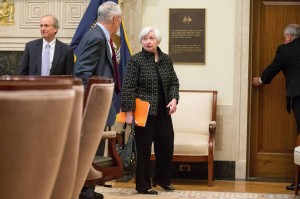Fed Adopts Dodd-Frank Bailout Limits
< < Go Back
Rule required under financial overhaul restricts unchecked ability to lend to banks during crisis.
The Federal Reserve on Monday adopted a rule curtailing its flexibility to set up loan programs in a crisis, seeking to assuage Capitol Hill concerns about the central bank’s broad powers to pump money into the financial system.
The rule was required by the 2010 Dodd-Frank financial overhaul law, which directed the Fed to limit emergency lending to “broad-based” programs rather than to a select few institutions. The Fed also would have to exclude insolvent institutions from the loans and demand enough collateral to protect taxpayers.
Many lawmakers had said the Fed operated with too few restrictions as it tried to keep big banks and other firms afloat during the 2008 financial crisis.
The Fed had proposed an earlier version of the rule that several lawmakers deemed inadequate. The tougher version approved Monday was aimed at addressing those concerns.
“We have received helpful and constructive comments from many sources on a rule to implement these Dodd-Frank Act provisions,” Fed Chairwoman Janet Yellen said in a statement. “In response to these comments, we have made significant changes to the proposed rule to ensure that our rule will be applied in a manner that aligns with the intent of the Congress and the Dodd-Frank Act.”
The rule would, among other things, require that every new Fed lending program be designed broadly enough that at least five potential recipients could be eligible to participate. That contrasts with several of the Fed’s rescue efforts during the crisis that were tailored for individual firms.
Under the rule, the Fed would only be able to use its emergency lending authority to provide assistance to an entire market or sector of the economy, rather than to specific firms or other recipients. That means the Fed wouldn’t be able to lend money to prop up a single failing firm or to keep one out of bankruptcy, Ms. Yellen said, “such as was done with loans to Bear Stearns and AIG ” during the 2007-09 financial crisis.
Fed officials said they copied the new requirement from legislation proposed by Sens. Elizabeth Warren (D., Mass.) and David Vitter (R., La.), two of the most vocal critics of the Fed’s emergency lending.
The rule also requires that only financially healthy institutions be allowed to borrow from the Fed and specifies that firms can’t borrow money to pass it on to insolvent entities.
Emergency lending programs would expire after one year, although the rule spells out provisions for extending them.
Responses from Congress were mixed. Mr. Vitter called Monday’s announcement “the first real acknowledgment from the Fed that it needed to do more to curtail its own bailout authority.”
But Texas Republican Jeb Hensarling, chairman of the House Financial Services Committee, said the central bank didn’t go far enough.
“By leaving the door wide open to future taxpayer-funded bailouts, this final rule compounds the moral hazard problem that lies at the core of ‘too big to fail,’” he said.
More From The Wall Street Journal (subscription required):




